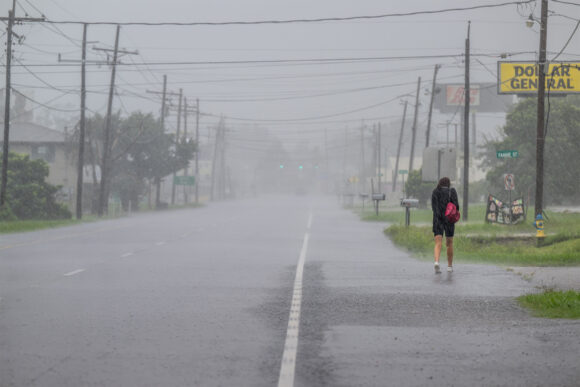Hurricane Francine packed power just as it slammed into the coast of Louisiana, reaching Category 2 strength with 100 miles per hour winds and a dangerous storm surge.
The storm made landfall in Terrebonne Parish, around 6 p.m. Eastern time Wednesday, according to the US National Hurricane Center. Francine hit a marshy and sparsely populated stretch of coastline about 85 miles west of New Orleans, which along with Baton Rouge is on alert for flash flooding.
“Heavy rains and hurricane-force winds are spreading inland across southern Louisiana,” National Hurricane Center forecasters said, warning residents to stay inside and away from windows in case of debris.
Within an hour of making landfall in Louisiana, Francine dropped back to a Category 1 hurricane with maximum winds of 90 mph (145 kilometers per hour). The storm is expected to continue weakening as it passes over land and could be downgraded from a tropical storm as soon as Friday morning, the hurricane center said.
The storm marks the end of an unusual lull in the Atlantic hurricane season, which went quiet in late August just as the season is normally approaching its peak. After several weeks of low activity, meteorologists now are tracking five storms or potential storms in the central Atlantic basin, including Francine.
Nearly 139,000 customers in Louisiana already are without power, according to Poweroutage.us. And 253 flights in Houston, New Orleans and Baton Rouge have been grounded, according to FlightAware, an airline tracker.
Hurricanes often lose some steam as they approach land, cut down by “wind shear,” or local winds moving in the opposite direction of the storm. But Francine managed to gain strength before striking Louisiana, said Alex DaSilva, lead hurricane expert for AccuWeather.
“A lot of that has to do with the extremely warm temperatures in the Gulf of Mexico,” DaSilva said. “Ocean heat content essentially is the depth of the warm water — how deep that extends down below the surface of the ocean. That’s at record levels for this time of the year.”
The storm will not make a direct hit on any of the region’s major natural gas export plants. Oil and gas companies had previously evacuated some offshore platforms in the Gulf of Mexico and shut in nearly 39% of oil production and 49% of gas production as a precaution.
Francine likely will cause $2 billion to $3 billion in damages and losses, said Chuck Watson, a disaster modeler with Enki Research.
This is now the third hurricane to strike mainland US in 2024, making it the ninth year since 1900 that has happened by Sept. 11, Phil Klotzbach, a hurricane researcher at Colorado State University, confirmed in an email to Bloomberg News. That’s partly because the storms that formed this year have developed in the central and western parts of the Atlantic basin.
Francine is expected to drench the southeastern US with heavy rainfall, which could cause flooding as far east as Tallahassee and the Florida Panhandle and as far north as Cape Girardeau, Missouri.
Photo: HOUMA, LOUISIANA – SEPTEMBER 11: A person walks through a downpour as Hurricane Francine hits the area on September 11, 2024 in Houma, Louisiana. Hurricane Francine maintains its Category 1 classification and is projected to make landfall along the Louisiana coast later this afternoon. Weather analysts are predicting 90mph winds near the eye and a strong storm surge along the coast. (Photo by Brandon Bell/Getty Images)
Was this article valuable?
Here are more articles you may enjoy.



 Group Sues California Department of Insurance Over FAIR Plan Surcharges
Group Sues California Department of Insurance Over FAIR Plan Surcharges  Trump’s Trade War Is Making US Farmers Anxious About Demand Risk
Trump’s Trade War Is Making US Farmers Anxious About Demand Risk  Wildfire Losses Drop Chubb Q1 Net Income 38%, While Tariffs Create ‘Confusion’
Wildfire Losses Drop Chubb Q1 Net Income 38%, While Tariffs Create ‘Confusion’  South Florida Insurance Broker Pleads Guilty to Fraud in $133M ACA Enrollment Scheme
South Florida Insurance Broker Pleads Guilty to Fraud in $133M ACA Enrollment Scheme 

